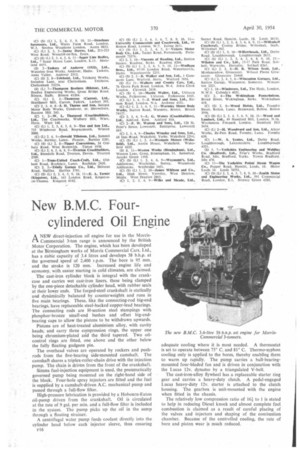New B.M.C. Four
Page 110

If you've noticed an error in this article please click here to report it so we can fix it.
cylindered Oil Engine
CAA NEW direct-injection oil engine for use in the MorrisCommercial 3-ton range is announced by the British Motor Corporation. The engine, which has been developed at the Birmingham works of Morris Commercial Cars, Ltd., has a cubic capacity of 3.4 litres and develops 58 b.h.p. at the governed speed of 2.400 r.p.m. The bore is 95 mm. and the stroke is 120 mm. Increased engine life and economy, with easier starting in cold climates, are claimed.
The cast-iron cylinder block is integral with the crankcase and carries wet cast-iron liners, these being clamped by the one-piece detachable cylinder head, with rubber seals at their lower ends. The forged-steel crankshaft is statically and dynamically balanced by counterweights and runs in five main bearings. These, like the connecting-rod big-end bearings, have replaceable steel-backed copper-lead bearings. The connecting rods are H-section steel stampings with phosphor-bronze small-end bushes and offset big-endbearing caps to allow the pistons to be withdrawn upwards.
Pistons are of heat-treated aluminium alloy, with cavity heads, and carry three compression rings, the upper one being chromium-plated and the third tapered. Two oilcontrol rings are fitted, one above and the other below the fully floating gudgeon pin.
The overhead valves arc operated by rockers and pushrods from the five-bearing side-mounted camshaft. The camshaft shares a triplex-roller-chain drive with the injection pump. The chain is driv'en from the front of the crankshaft.
Simms fuel-injection equipment is used, the pneumatically governed pump being mounted on the right-hand side of the block. Four-hole spray injectors are fitted and the fuel is supplied by a camshaft-driven A.C. mechanical pump and passed through a full-flow filter.
High-pressure lubrication is provided by a Hobourn-Eaton oil-pump driven from the crankshaft. Oil is circulated at the rate of 9 gal. per min. and a full-flow filter is included in the system. The pump picks up the oil in the sump through a floating strainer.
A centrifugal water pump feeds coolant directly into the cylinder head below each injector sleeve, thus ensuring adequate cooling where it is most needed. A thermostat is set to operate between 75° C. and 81° C. Thermo-syphon cooling only is applied to the bores, thereby enabling them to warm up rapidly. The pump carries a ball-bearingmounted four-bladed fan and is driven in conjunction with the Lucas 12v. dynamo by a triangulated V-belt.
The cast-iron-alloy flywheel has a replaceable starter ring gear and carries a heavy-duty clutch. A pedal-engaged Lucas heavy-duty 12v. starter is attached to the clutch housing. The gearbox is unit-mounted with the engine when fitted in the chassis.
The relatively low compression ratio of 10 to 1 is stated to help in reducing Diesel knock and almost complete fuel combustion is claimed as a result of careful placing of the valves and injectors and shaping of the combustion chamber. Because of the controlled cooling, the rate of bore and piston wear is much reduced.




















































































































































































































































